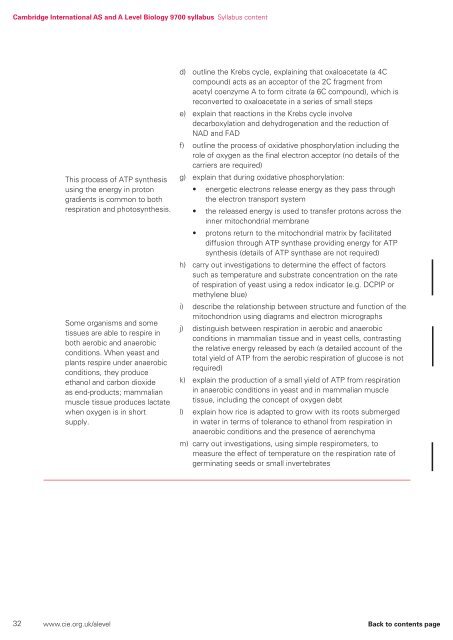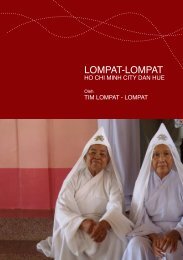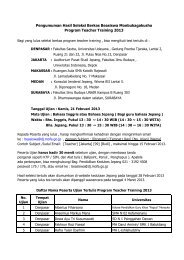9700_y16_sy
9700_y16_sy
9700_y16_sy
Create successful ePaper yourself
Turn your PDF publications into a flip-book with our unique Google optimized e-Paper software.
Cambridge International AS and A Level Biology <strong>9700</strong> <strong>sy</strong>llabus Syllabus content<br />
This process of ATP <strong>sy</strong>nthesis<br />
using the energy in proton<br />
gradients is common to both<br />
respiration and photo<strong>sy</strong>nthesis.<br />
Some organisms and some<br />
tissues are able to respire in<br />
both aerobic and anaerobic<br />
conditions. When yeast and<br />
plants respire under anaerobic<br />
conditions, they produce<br />
ethanol and carbon dioxide<br />
as end-products; mammalian<br />
muscle tissue produces lactate<br />
when oxygen is in short<br />
supply.<br />
d) outline the Krebs cycle, explaining that oxaloacetate (a 4C<br />
compound) acts as an acceptor of the 2C fragment from<br />
acetyl coenzyme A to form citrate (a 6C compound), which is<br />
reconverted to oxaloacetate in a series of small steps<br />
e) explain that reactions in the Krebs cycle involve<br />
decarboxylation and dehydrogenation and the reduction of<br />
NAD and FAD<br />
f) outline the process of oxidative phosphorylation including the<br />
role of oxygen as the final electron acceptor (no details of the<br />
carriers are required)<br />
g) explain that during oxidative phosphorylation:<br />
• energetic electrons release energy as they pass through<br />
the electron transport <strong>sy</strong>stem<br />
• the released energy is used to transfer protons across the<br />
inner mitochondrial membrane<br />
• protons return to the mitochondrial matrix by facilitated<br />
diffusion through ATP <strong>sy</strong>nthase providing energy for ATP<br />
<strong>sy</strong>nthesis (details of ATP <strong>sy</strong>nthase are not required)<br />
h) carry out investigations to determine the effect of factors<br />
such as temperature and substrate concentration on the rate<br />
of respiration of yeast using a redox indicator (e.g. DCPIP or<br />
methylene blue)<br />
i) describe the relationship between structure and function of the<br />
mitochondrion using diagrams and electron micrographs<br />
j) distinguish between respiration in aerobic and anaerobic<br />
conditions in mammalian tissue and in yeast cells, contrasting<br />
the relative energy released by each (a detailed account of the<br />
total yield of ATP from the aerobic respiration of glucose is not<br />
required)<br />
k) explain the production of a small yield of ATP from respiration<br />
in anaerobic conditions in yeast and in mammalian muscle<br />
tissue, including the concept of oxygen debt<br />
l) explain how rice is adapted to grow with its roots submerged<br />
in water in terms of tolerance to ethanol from respiration in<br />
anaerobic conditions and the presence of aerenchyma<br />
m) carry out investigations, using simple respirometers, to<br />
measure the effect of temperature on the respiration rate of<br />
germinating seeds or small invertebrates<br />
32 www.cie.org.uk/alevel Back to contents page





